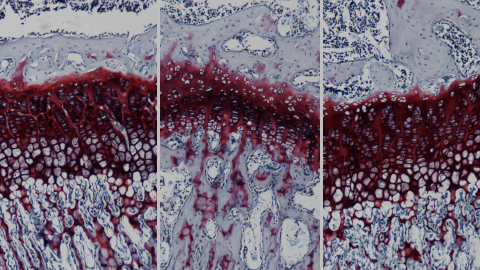Treatment with gene therapy of a new rat model of Morquio A

A research team from the Universitat Autònoma de Barcelona (UAB) has generated the first rat model recapitulating all disabling alterations experienced by patients with Mucopolysaccharidosis type IVA, also known as Morquio A disease. The team has developed a gene therapy that fully corrects the severe whole-body alterations in the rat model after a single intravenous viral vector administration.
09/09/2021
Mucopolysaccharidosis type IVA, also known as Morquio A disease, is a rare disease caused by a deficiency of the GALNS enzyme, which causes alterations in bone growth (skeletal dysplasia), a rapid deterioration of cartilage and complications in the heart and trachea which result in cardiorespiratory complications that can cause premature death. The first symptoms are detected in very young children (about 2-year-old), and in the most severe cases, death generally occurs around 20 years of age. There is no cure for this disease and the current therapy, based on enzymatic replacement, cannot correct skeletal abnormalities.
Researchers at the UAB have generated the first rat model of Morquio A disease that fully reproduces the severity of the disease, in contrast to existing mouse models, especially skeletal dysplasia, early cartilage deterioration, and heart valves and trachea alterations, similarly to human patients. Using the CRISPR/Cas9 genome editing technology, the authors generated a rat carrying a mutation in the genome that causes the most frequent and severe form of this disease in humans.
Afterwards, the researchers developed the first gene therapy approach that reverted the whole plethora of pathological alterations of Morquio A disease in the new rat model. This gene therapy is based on the intravenous adminisitratation of a viral vector coding for the GALNS enzyme. The gene therapy mediated widespread biodistribution and ubiquitous expression of the therapeutic gene, particularly throughout the whole skeletal system. This allowed long-term production of the enzyme in all afflicted tissues, thus preventing alterations in bones, as well as in cartilage, trachea and heart.
“Administration of the gene therapy in four-weeks-old Morquio A rats completely reverted the clinical signs of the disease, such as bone growth alterations, dental malformations and fragility, articular cartilage pathology, and also the respiratory and cardiovascular complications”, explains Fatima Bosch, the UAB researcher and director of the study.
Presently, no gene therapy approach is being applied to treat Morquio A patients. This new therapy developed at the UAB results in sustained production of the enzyme throughout the body and particularly within the bones. Therefore, it could be used to treat children diagnosed with the disease at early ages, when the bone formation is very active and the skeletal alterations are not irreversible.
“The gene therapy developed by our team has the potential to correct the disabling Morquio A disease in humans. Nevertheless, studies investigating biodistribution and long-term safety of the therapeutic vector in large animals are required before moving the treatment to clinical phase”, Dr. Bosch concludes.
The study, published on September 9th in Nature Communications, was coordinated by the UAB researcher Fàtima Bosch, who is also director of the Centre for Animal Biotechnology and Gene Therapy (CBATEG) at the UAB. The work has been performed by researchers from the CBATEG and Departments of Biochemistry and Molecular Biology, Animal Health and Anatomy, School of Veterinary Medicine at the UAB; the Centro de Investigación Biomédica en Red de Diabetes y Enfermedades Metabólicas Asociadas (CIBERDEM); and the Molecular Image Unit at the Spanish National Cancer Research Centre (CNIO).
Image:
Histological analysis of sections of the growth plate (GP), the active bone growth area. Left panel, the GP of a healthy rat. Middle panel, GP from a Morquio A rat, showing severely reduced growth activity. Right panel, the GP from a Morquio A rat treated with the gene therapy, in which growth activity is recovered and is similar to that of a healthy rat.
This information is related to the following SDG
Good health and well-being